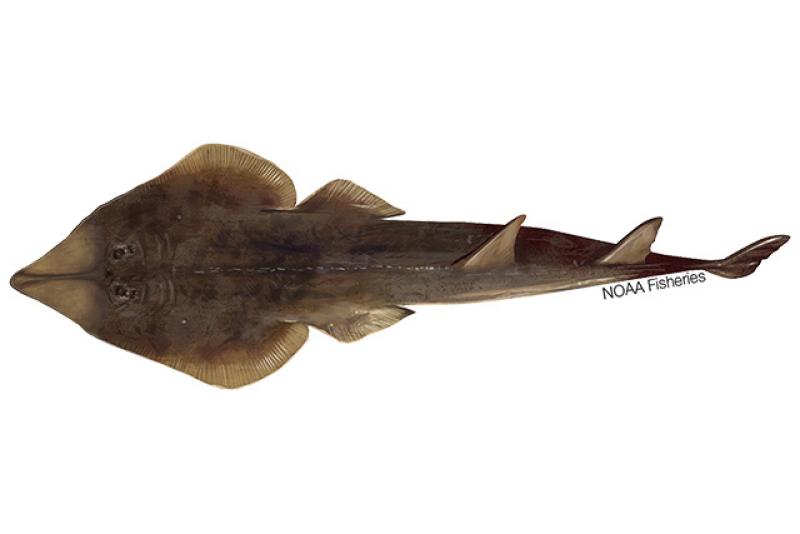About the Species
The Brazilian guitarfish is a cartilaginous fish, similar to skates and rays. The species once commonly occurred off the coast of southern Brazil, but due to significant fishing pressure, particularly on pregnant females, the species experienced a significant decline and population collapse in 1986. The main threat to the Brazilian guitarfish is overfishing and bycatch in various commercial and artisanal fisheries operating in its coastal inshore habitat. In 2017, NOAA Fisheries listed the species as endangered under the Endangered Species Act.
Appearance
The Brazilian guitarfish is olive grey or chocolate brown in color and lacks light or dark markings. It has long nostrils and a “sooty” patch on its snout, with a transversely flat or a slightly convex crown. The species also has a row of large, thorn-like nodules running down the middle of its back. The dorsal fins are triangular and similar in size. All guitarfishes have a moderately depressed, elongated, shark-like body form, two equal, well-developed, and well-separated dorsal fins, and an elongated, wedge-shaped snout.
Behavior and Diet
There is very little information on the diet or feeding behavior of Brazilian guitarfish. Based on one study from Argentina, the species likely eats Patagonian octopus (Octopus tehuelchus), shrimp (Hymenopeneus muelleri), decapods, isopods, and polychaetes.
Where They Live
Although the Brazilian guitarfish occurs in the southwestern Atlantic from Rio de Janeiro, Brazil (possibly north to the Bahia) to Mar del Plata, Argentina (and possibly further south), the species’ center of distribution and abundance is concentrated between 28° S and 34° S in southern Brazil, and is elsewhere rare. Adult Brazilian guitarfish live in shallow, coastal waters between November and March when pupping and mating occur, and move offshore for the rest of the year to waters of depths of 130 feet. Newborns and juveniles live in shallow coastal waters in depths of less than 66 feet year round.
 World map providing approximate representation of the Brazilian guitarfish's range.
World map providing approximate representation of the Brazilian guitarfish's range.
Lifespan & Reproduction
Female Brazilian guitarfish may live to be between 14 and 28 years of age, while male Brazilian guitarfish may live to be between 10 and 15 years of age. Female Brazilian guitarfish give birth annually, after about an 11 to 12 month pregnancy, to litters of between 4 and 12 pups, depending on the size of the mother.
Threats
Overfishing
The primary threat to the Brazilian guitarfish shark is overfishing in commercial and artisanal fisheries. The species is caught as bycatch in commercial trawl fisheries as well as artisanal beach seines and fixed nets. These fisheries operate throughout the species’ habitat year-round, including in its nursery grounds where large numbers of pregnant females are caught.
Scientific Classification
| Animalia |
Chordata |
Chondrichthyes |
Rhinopristiformes |
Rhinobatidae |
Rhinobatos |
horkelii |
Last updated by NOAA Fisheries on 11/21/2024




